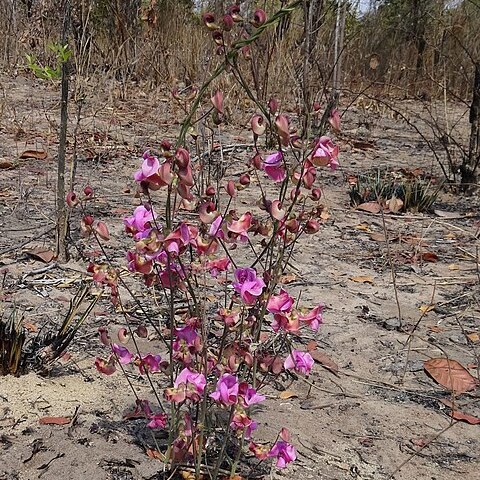Leaflets 3, 3.5–9.5 × 0.4–6.5 cm, ovate-oblong, lanceolate or subrhombic-oblong, obtuse at the apex, cuneate, rounded or minutely subcordate at the base, mostly rather leathery, glabrescent or rather roughly pilose on both surfaces; venation raised and closely reticulate on both surfaces; petiole 3–13 cm long; rhachis 1–2.6 cm long; stipules 4–10 × 1–3 mm, ovate to lanceolate, usually slightly bilobed but sometimes peltate or almost truncate, multinerved.
Flower 13–25 mm long; pedicel 1–3 mm long, not expanding as the pod matures; bracts at base of peduncles in leafless state are short stipules; true bract 1–3 × 1–1.5 mm, oblong; bracteoles 1–3 × 0.5–1.5 mm, oblong-lanceolate, usually 1-nerved, rarely multinerved.
Stem at first erect, later prostrate or, less often, climbing, 6 cm to 1.8 m tall or long, glabrous or puberulous on the leafy shoots, densely pubescent or setulose when young but later glabrescent.
Standard asymmetrical, with 2 parallel widely spaced appendages; keel twisted towards the right as well as incurved and bearing an upwardly directed pocket on the left-hand petal.
Calyx sparsely to moderately pubescent; tube c. 4 mm long; lobes 2–9 mm long, subequal, the upper pair joined for half their length or almost to quite free.
Perennial herb from a thick, often extensively branched, frequently horizontal woody rootstock, nearly always flowering before the leaves appear.
Peduncle 4–20 cm × 1.5–3 mm, shortly pubescent or scabrous; rhachis 2–5 cm long, 2–6-noded, internodes 2–13 mm long, rarely up to 22 mm long.
Pods 7–11 cm × 4–7 mm, linear-cylindrical, slightly compressed, sparsely puberulous, with a straight beak.
Seed 5.5–8 × 3–4 × 2–3 mm; hilum central, 1.5–3 mm long; rim aril slightly developed.
Ovary 7–15-ovuled.


